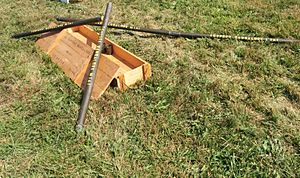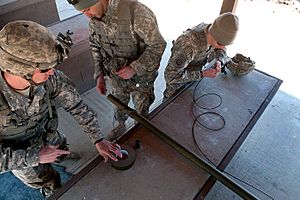Bangalore torpedo facts for kids
Quick facts for kids Bangalore torpedo |
|
|---|---|
 |
|
| Type | Explosive charge |
| Place of origin | British India |
| Service history | |
| In service | 1914–present |
| Used by |
|
| Wars | |
| Production history | |
| Designer | Captain R. L. McClintock |
| Designed | 1912 |
| Produced | February 1943–November 1944 (M1A1) |
| No. built | Approximately 3,255,000 torpedo sections (M1A1) |
| Variants | M1 Bangalore Torpedo series, Advanced Performance Bangalore Torpedo (L26A1 Bangalore Torpedo Demolition Charge), Bangalore Blade |
| Specifications | |
| Mass | 13 lb (5.9 kg) per torpedo section (M1A1) |
| Length | up to 15 m (49 ft) in 1.5 m (4.9 ft) sections (general), 5 ft (1.5 m) (M1A1) |
| Diameter | 2.125 in (54.0 mm) (M1A1) |
|
|
|
| Filling | TNT, 80-20 TNT and ammonium nitrate (M1A1), C4 (modern production) |
| Filling weight | 9 lb (4.1 kg) per torpedo section (M1A1) |
|
Detonation
mechanism |
Detonator |
| References | Catalogue of Standard Ordnance Items, Second Edition 1944 Volume III, p. 598 |
A Bangalore torpedo is a special explosive device. It's made of several tubes joined together, filled with explosives. Soldiers, especially combat engineers, use it to clear paths. Imagine needing to get through thick barbed wire or other obstacles. Instead of getting close, they can push this long explosive tube forward. When it blows up, it creates a safe path, usually about 3 to 4 meters (10 to 13 feet) wide. People sometimes call it a "banger" or a "pole charge".
Contents
What is a Bangalore Torpedo?
The Bangalore torpedo was invented in 1912. Captain R. L. McClintock of the Royal Engineers created it. He was working with the Madras Sappers and Miners in Bangalore, India. His goal was to safely clear away old booby traps and barricades. These were left over from earlier wars like the Second Boer War. The torpedo allowed soldiers to blow up obstacles from about 3 meters (10 feet) away. This meant they didn't have to get too close to dangerous areas.
Modern versions of the Bangalore torpedo are still made today. Companies like Mondial Defence Systems and Chemring Energetics UK have produced them. An improved version, the Advanced Performance Bangalore Torpedo (APBT), was developed in 2008. It's used by countries like the UK, Australia, and the Netherlands. These torpedoes are still helpful for clearing mines or razor wire in conflicts, such as the Afghanistan War.
Bangalore Torpedoes in World War I
During World War I, the Bangalore torpedo became very important. Soldiers used it mainly to clear barbed wire before an attack. This was especially useful in trench warfare, where soldiers fought from protected ditches. The torpedo could be pushed out from a trench and detonated safely.
The torpedo was made of several 1.5-meter (5-foot) long pipes. One pipe held the explosive charge. Soldiers could screw these pipes together to make a longer tube. A smooth nose cone was added to the end. This stopped the torpedo from getting stuck on the ground. When it exploded, it made a 1.5-meter (5-foot) wide hole in the barbed wire. This helped soldiers move forward during battles. For example, in the 1917 Battle of Cambrai, British engineers used them. They sometimes used them as a distraction to trick the enemy.
Bangalore Torpedoes in World War II
The Bangalore torpedo was also used in World War II. The U.S. Army adopted its own version, called the "M1A1 Bangalore torpedo". These torpedoes came in wooden crates. Each crate held 10 torpedo sections, connecting parts, and a nose cone. Each section was about 1.5 meters (5 feet) long and weighed about 5.9 kg (13 pounds).
The torpedo sections were filled with explosives like TNT. They could be joined together with special sleeves. A blunt nose cone helped push the torpedo through obstacles. This made it easy to use in different terrains. The U.S. Army used them a lot, especially during the D-Day landings. However, by D-Day, the British Army had started using newer, more powerful tools. These included rocket-launched systems and special armored vehicles.
Modern Uses and New Designs
After World War II, the Bangalore torpedo continued to be used. Both the U.S. Army and the People's Army of Vietnam used it during the Vietnam War. In 1973, during the Yom Kippur War, Israeli forces used them. They cleared paths through Syrian minefields.
Today, Bangalore torpedoes are still in use. They come in updated versions like the M1A2 and M1A3 for the U.S. military. The British military uses the L26A1, also known as the Advanced Performance Bangalore Torpedo (APBT). Soldiers sometimes even make their own versions in the field. They use metal posts and plastic explosives to create similar long charges.
Newer designs, like the Alford Technologies Bangalore Blade, are even more advanced. The Bangalore Blade is made of lightweight aluminum. It's designed to cut through wire obstacles more effectively. It creates a wider gap than older versions. For example, a test showed it could clear a 10-meter (33-foot) path through razor wire. The APBT also uses an aluminum body and special explosives. It's designed to have better blast and cutting effects. It can even cut through steel plating up to six millimeters thick. These new designs make the Bangalore torpedo even more useful for clearing obstacles.
Other Path-Clearing Tools
The U.S. military is also bringing in new tools to replace the Bangalore torpedo. One example is the anti-personnel obstacle breaching system (APOBS). These systems are easier to use and can clear much longer paths. They offer more flexibility for soldiers in the field.
See also
- Canadian pipe mine
- Mine-clearing line charge





